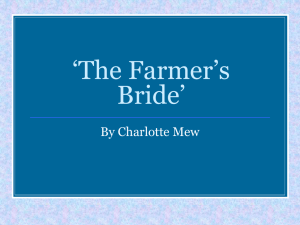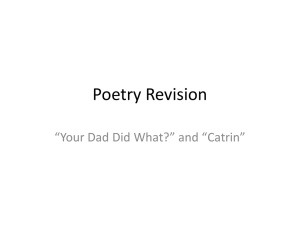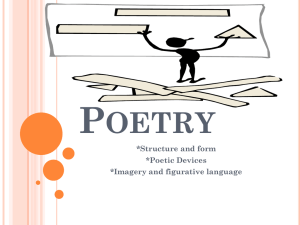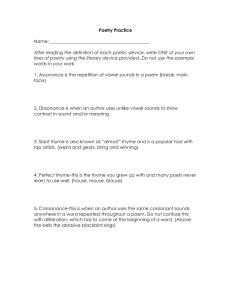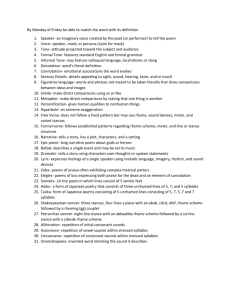Glossary of Poetic Terms
advertisement
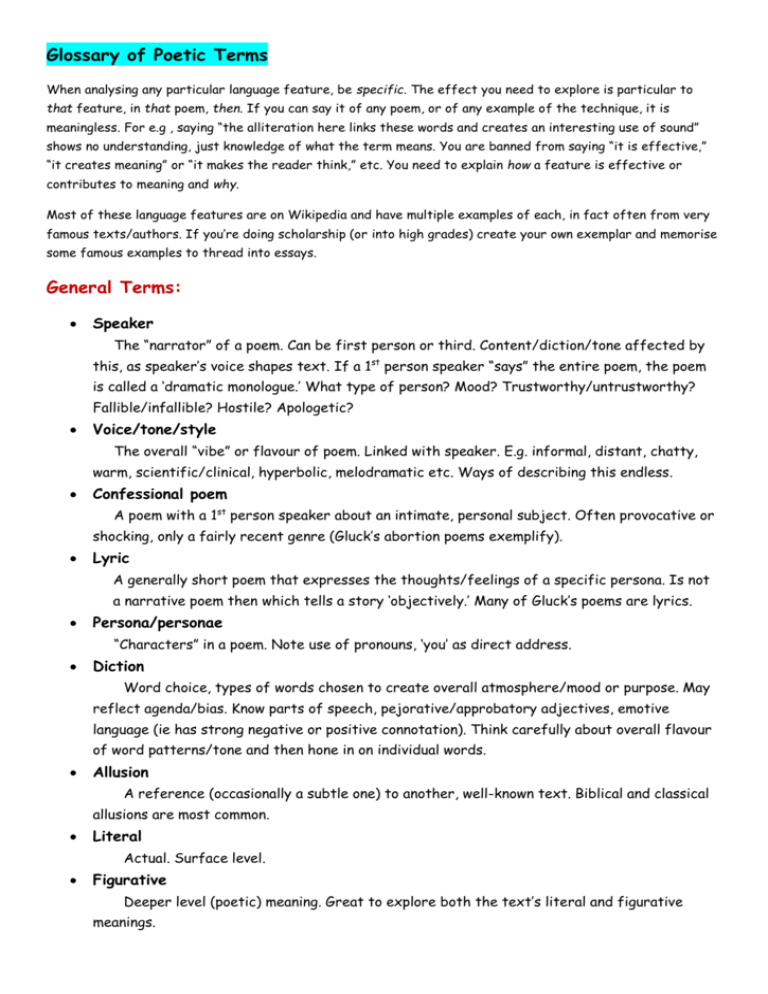
Glossary of Poetic Terms When analysing any particular language feature, be specific. The effect you need to explore is particular to that feature, in that poem, then. If you can say it of any poem, or of any example of the technique, it is meaningless. For e.g , saying “the alliteration here links these words and creates an interesting use of sound” shows no understanding, just knowledge of what the term means. You are banned from saying “it is effective,” “it creates meaning” or “it makes the reader think,” etc. You need to explain how a feature is effective or contributes to meaning and why. Most of these language features are on Wikipedia and have multiple examples of each, in fact often from very famous texts/authors. If you’re doing scholarship (or into high grades) create your own exemplar and memorise some famous examples to thread into essays. General Terms: Speaker The “narrator” of a poem. Can be first person or third. Content/diction/tone affected by this, as speaker’s voice shapes text. If a 1st person speaker “says” the entire poem, the poem is called a ‘dramatic monologue.’ What type of person? Mood? Trustworthy/untrustworthy? Fallible/infallible? Hostile? Apologetic? Voice/tone/style The overall “vibe” or flavour of poem. Linked with speaker. E.g. informal, distant, chatty, warm, scientific/clinical, hyperbolic, melodramatic etc. Ways of describing this endless. Confessional poem A poem with a 1st person speaker about an intimate, personal subject. Often provocative or shocking, only a fairly recent genre (Gluck’s abortion poems exemplify). Lyric A generally short poem that expresses the thoughts/feelings of a specific persona. Is not a narrative poem then which tells a story ‘objectively.’ Many of Gluck’s poems are lyrics. Persona/personae “Characters” in a poem. Note use of pronouns, ‘you’ as direct address. Diction Word choice, types of words chosen to create overall atmosphere/mood or purpose. May reflect agenda/bias. Know parts of speech, pejorative/approbatory adjectives, emotive language (ie has strong negative or positive connotation). Think carefully about overall flavour of word patterns/tone and then hone in on individual words. Allusion A reference (occasionally a subtle one) to another, well-known text. Biblical and classical allusions are most common. Literal Actual. Surface level. Figurative Deeper level (poetic) meaning. Great to explore both the text’s literal and figurative meanings. Symbol Something that stands in for something else. E.g. darkness = ignorance. Have to argue something is symbolic and be persuasive. Motif A word, idea, image that’s repeated to accumulate meaning (often symbolic). Hands are a motif of male power in Gluck’s poetry. Sense detail Detail that evokes physical senses. Synesthesia is a technique that blurs senses e.g “ lemony sunshine” blurs sight and taste. Concrete detail A physical detail. It “shows” not “tells” info and is often more meaningful/interesting. Figurative Language: Metaphor Direct comparison between two things. Identify which two things specifically and explore similarities and difference between them. E.g. “My chest is a suitcase I have to sit on” links ‘chest’ and ‘suitcase.’ Both suggest cavity/containers, that are full, (of personal stuff? Emotions?) and that represent a struggle for the speaker to close (repress? Contain?). Idea of travel alluded to, and possible struggle for self-control. Feeling of suffocation? Extended metaphor Metaphor which is developed over more than one sentence, sometimes for entire poem or text. Simile Comparison using like or as. Analyse like a metaphor. Consider carefully why these two elements are being linked. Personification Imbuing inanimate things with animate/living qualities. Consider carefully what exactly (emotion, stance, attitude, behaviour, appearance etc) is being highlighted by this technique. Is it comfortingly alive or threatening etc? e.g. ‘the trees hug their shadows closely to them’ suggest trees and shadows have intimate, affectionate relationship and give clear visual image of shadows being small (and time of day…midday etc) Image Word picture, appeals to visual sense. Is concrete and striking for reader. Again, consider whether is ominous/ disturbing/ serene/ otherwordly etc. Endless ways to analyse. Consider how objects are placed, scale, colour etc Sound Devices: Alliteration Two or more words beginning with same consonant. Enriches sound of poem; can have staccato/legato effect, euphony/cacophony can be created (harmonious sound vs discordant). Carefully consider why those particular words are being linked by sound. Also creates rhythm. Sibilance Alliteration of S. Makes hissing sound, often deliberately cacophonous. Look at linking. Consonance Repetition of consonants, eg “The clutter and rattle of kitchen pots” repeats “t” sound, staccato effect, is noisy. Assonance Repetition of vowel sounds. Can create rhyme/half rhyme, link words, general a legato effect. E.g. “on a proud round cloud in white high night.” Rhyme - True rhyme = words have same vowels and consonants in at least the suffix - Half rhyme (Pararhyme or slant rhyme) = words nearly rhyme but is off, often used to create sense of unease. eg Wilfred own uses it when linking “snow” with “now,” “star” with “stir” and “tall” with “toil” in Futility. As title suggests, is poem about hopelessness and this half rhyme leaves us with an uneasy sense of disconnectedness. - End rhyme = words on end of poems’ line that rhyme. Coupled with regular metre aid memory, create structural linking. Not used often in modern poetry. Can get predictable unless done with skill. - Internal rhyme = Words within a line rhyme, builds momentum, rhythm, links words. - Incremental rhyme = Rhyming words build up and acculumlate, 3 or even more. Roger McGough’s No Surprises does this relentlessly. - Masculine/ feminine rhyme = masculine are rhymes of 1 syllable e.g “tomb/womb” whereas feminine are two or more “despises/disguises.” - Forced rhyme = making rhyme fit by adding words “surprises/demise is.” Rhythm Created by syntax, arrangement of sentences on lines, diction. Note especially where rhythm is broken, as this can be mined for meaning. Onomatopoeia A word that’s sound echoes the meaning. “Rattle,” with staccato consonants makes rattle sound. Repetition Can be incremental, internal (like rhyme). If a phrase is repeated it can be called a “refrain.” If a word is, it can be called a “motif.” Structural Features/Form Caesura A fullstop mid line. Creates pause in rhythm, often to emphasise particular word/idea preceding or following it. Think carefully which words are given priority by this. Enjambment/line break A “run on line” where the sentence spans two or more lines. Again, think carefully which words are prioritised by this. Especially consider the word that now begins the line, but not the sentence and is therefore emphasised. Read all words that begin every line (down left side of poem) and look for patterns, mine for meaning. e.g. Glen Colquhoun’s “Lament” has a regular stanza pattern where most stanzas have 3 lines within them that each begin with “it/if/or.” This pattern shows us that each stanza hinges on a conditional clause. End stopped line Full stop at end of line. Again, can emphasise preceding or following word or both. You need to think about why. Stanza Verses, like paragraphs in prose. How are they grouped and why? Content? Any changes in tone? Where and why are there new stanzas created? Are they numbered, titled in anyway. Consider why. Titles always hint at key ideas. Blank/free verse Poetry (modern) which has no regular rhyme or rhythm patterns. It does still have rhythmic organisation and patterns (of sound and meaning) though, and you need to perhaps think carefully to spot them and consider how and why that’s created. Metre Regular rhythm of stressed and unstressed syllables. Iambic pentameter Used in Shakespeare, among other writers. Has 5 stressed and 5 unstressed syllables. (Da dum. Da dum. Da dum. Da dum. Da dum.) eg Iago says: O monstrous world! Take note, take note, O world, To be direct and honest is not safe. I thank you for this profit; and from hence I'll love no friend, sith love breeds such offence. Couplet (Heroic) Two lines that represent a complete thought. If they have end rhyme, it’s called a heroic couplet. Again, found in Shakespeare, among others. Often used at end of an Act to show it is the end, instead of having curtain close (no curtains in the Globe). Eg Desdemona says: Good night. Good night. Heaven me such uses send. Not to pick bad from bad, but by bad mend.




